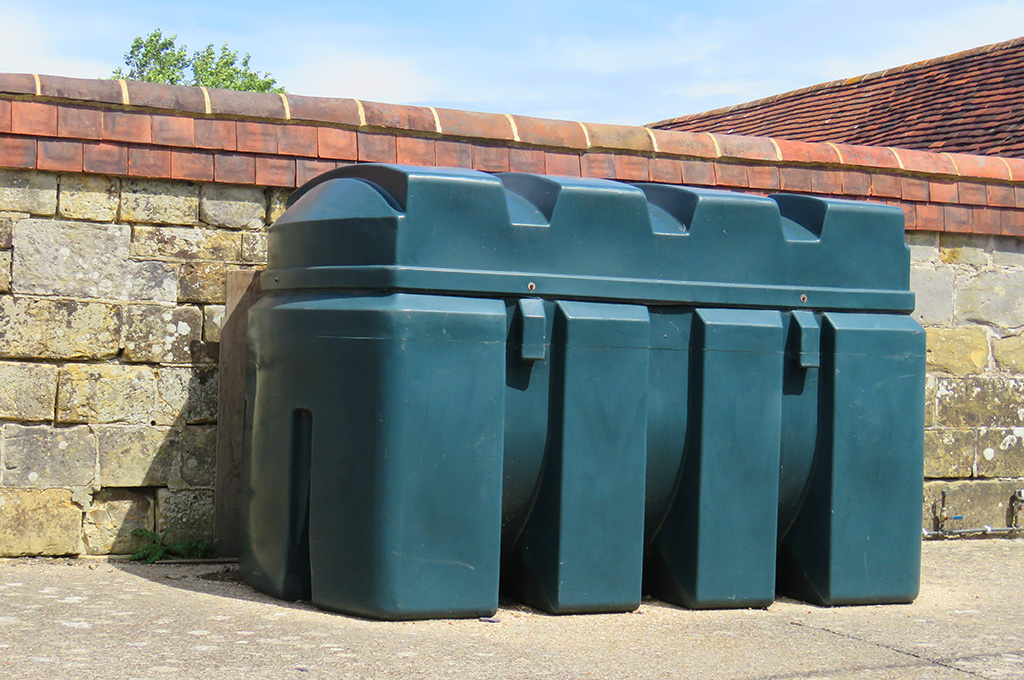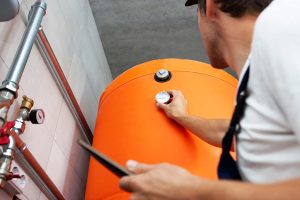If you rely on oil-powered heating for your home, you need an oil storage tank that you can trust. An oil tank requires vigilance and maintenance to operate at its best.
Here are some of the most common issues with heating oil tanks, and our top tips to prevent or fix any problems with your storage solution.
1. Heating oil tank leaks
As domestic heating oil tanks are commonly found outdoors, any leak has the potential to cause damage to the environment. Leaking tanks can put a strain on your wallet as you lose valuable fuel. You may also risk defying pollution laws inadvertently. It’s crucial to address any oil leak quickly and correctly.
The most common cause of domestic oil tank leaks is tank age. Sometimes the tank as a whole starts to weaken. Other times, individual components will deteriorate over time. Either way, old, worn out components can cause costly leaks.
How to fix a leaking heating oil tank:
If you notice a leak coming from your tank, aim to identify the source and plug the hole immediately. Take measures to stop the spread of oil, such as catching drips in a bucket.
In no circumstances should you try to wash the oil away or apply detergent to the area. Instead, aim to minimise the impact of the spill. If the leak reaches a local water supply, you’ll need to contact your local environmental protection agency as soon as possible.
Ask a professional to come and carry out any repairs to your oil tank as soon as possible. Contact our team on sales@heatingoil.co.uk or fill out a form, and we’ll arrange for your local OFTEC-registered engineer to get your heating back up and running again.
2. Sludge & water inside your heating oil tank
It’s not uncommon for sludge or water to get inside your tank. This build up of sludge can clog up the pipework, damage your heating system, and reduce the efficiency of your heating oil. But how does this happen?
Water can seep into your tank if it’s raining when your oil is delivered, or from condensation. Meanwhile, sludge tends to build up in tanks where oil has been stored for a long time.
For more information, read our guide to water in oil tanks.
What to do if water and sludge gets inside your heating oil tank:
Keep an eye out for darkened areas at the bottom of your tank, as this can signify erosion from sludge. You can also buy water-finding paste, which changes colour to indicate whether water is present.
If your tank is empty, a technician can remove water and sludge, and clean your tank. They’ll also fix whatever’s causing the initial problem. If your tank is left for too long with water inside, you may have no choice but to replace your tank completely.
A quick fix to stop water from entering your tank is to rub a bar of soap into any splits/cracks. Duct tape can also seal small weak points in the short-term. These tactics are just quick and temporary fixes whilst you await a new tank.
Want to make sure that your tank is working efficiently and safely? Arrange an annual inspection by a local OFTEC-registered engineer.
3. Corrosion on your heating oil tank
Cosmetic damage is typically a sign of your tank growing weaker. Usually, the damage will appear as spots of rust or dents in the shell. A few dents and spots may not seem like a big deal. However, corrosion can quickly lead to leaks if the paint is chipped and exposes the underlying metal to the elements.
When metal interacts with water and air, it can turn into rust that thins the wall between your oil and the outside world. If you let dents and corrosion develop, your tank will become weaker and weaker, and you’ll eventually spring a leak. Leaks can cause unnecessary financial expenses, so it’s important to take proactive steps to reduce the likelihood of oil tank corrosion.
How to prevent heating oil tank corrosion:
Identifying issues early on could be the difference between vital repair work or having your heating oil tank replaced completely. Play it safe by getting into the habit of checking your tank at least once every couple of months.
4. Heating oil smell
It can be far from comforting if your house smells like heating oil. In general, you shouldn’t be able to smell heating oil inside your home. If you’re smelling a distinct oily odour, it could be a sign that there’s a problem.
The smell shouldn’t be a cause for concern if you’ve:
- Recently refilled your tank
- Turned on the furnace or heating system for the first time in a while
- Got a dirty furnace filter.
On the other hand, a persistent smell can be a sign of something more serious. You may have a problem with your furnace, a leak in your oil tank, or an oil spill. If you have one of these issues on your hands, you’ll need a professional to help you clean up and remove the heating oil fumes from your home.
How to get rid of a heating oil smell:
Once you’ve cleaned the spill, the smell of oil may still linger in the air. Here are additional methods you can use to eliminate the heating oil smell for good:
- Sprinkle a powder detergent or baking soda: Find a laundry detergent with a sweet scent or use baking soda to cover the spill area.
- Place vinegar near your furnace: The heating oil smell may result from a furnace problem, rather than a spill. You can clear the air by placing small dishes filled with vinegar near your furnace in front of each vent. Repeat this each day with fresh vinegar until the smell has disappeared completely.
- Use fragrant air fresheners: Try to use regular air fresheners with a strong scent and spray them in the area and throughout your home.
Read our guide to oil tank safety, to avoid any risks – whatever tank type you own.
5. Heating oil theft
Another issue with heating oil tanks is that, the older they are, the more attractive they are to thieves. Potential thieves recognise that your tank’s structure may be weaker and easier to breach. A new tank presents a much stronger challenge to potential oil thieves and may deter their attempts.
How to prevent heating oil tank theft:
- Shield your tank from view so it isn’t visible from the road. Of course, whilst doing so, make sure your tank’s position still complies with safety and access guidelines.
- Install motion-sensitive security lighting to alert you to any problem.
- Consider installing an alarm sensor that will react if the oil level drops suddenly. These gauges are also useful for spotting a leak.
Learn more useful tips in our guide to protecting against oil theft.
DIY heating oil tank checks:
Besides getting your oil tank serviced annually, there are simple checks and precautions you should take to make sure your tank is in good condition, such as:
- Checking for damage, such as bulges, deep scratches, cracks, discolouration, rust or major dents.
- Looking out for any oil that has leaked out, particularly around pipes, valves and seams.
- Making sure that any external protection isn’t filled with water, oil, rubbish or weeds.
- Keeping access to and around the tank clear.
- Ensuring vents, gauges and access points are closed and protected so that rainwater, insects or dirt can’t get in.
- Checking that oil gauges and alarms are working correctly, including their batteries.
- Keeping an oil-spill kit with drain blockers, leak-sealing putty and absorbent materials.
- Making sure that your tank is only filled to around 80% of its capacity and ensuring that your tank has an overfill protection device alarm.
If your heating oil tank is old, or starting to show signs of damage, get in touch with our friendly team. We carry our maintenance checks, and supply heating oil tanks in various sizes, which are all installed by OFTEC registered engineers.
Learn more about our heating oil tank service today.





